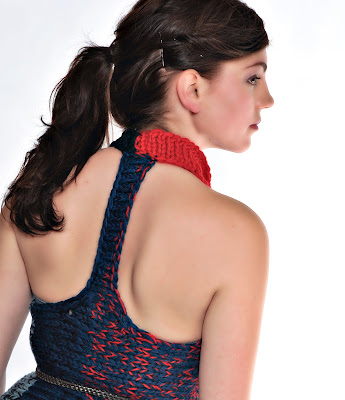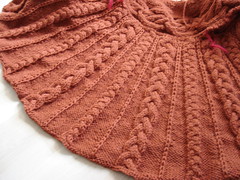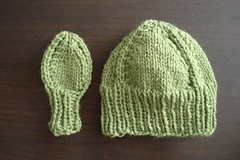-Lesley Buxton
Knitting Never Felt Better: The definitive guide to fabulous felting.

This is a closely fitted vest pattern, ribbed at the hem, rolled collar and designed with a youthful t- back. Knit in a size larger for a looser and cozier feel or knit to your size for a more fitted and tailored look. A contemporary style designed with four strands of steadfast Cascade 220 yarn in mind.

The Halo Vest is a great piece to layer for coolers days, and adds a bit of stylish fun to any outfit. This is a go-to piece in any wardrobe and great for back to school. Wear the vest open or use a button, chopstick, or belt to secure.
Knit with the gradation in mind makes for a great yarn buster. When using up stash yarn, sit back and watch to see what fabric you create. Have fun with it -- but for best results, stick with yarns of similar weight and do take the time to check your gauge.

The first time I ever laid eyes on a skein of Noro Yarn I was in New York City back in the 00s. Today, I couldn’t tell you which yarn shop as I was at as I was booting it from shop to shop checking out each space as fast as I could in order to meet up with my husband a few short hours later. What I do remember is that this Noro yarn spoke to me. Never before had I seen such a combination of fibres, such earthy, acidy colours, such texture. Choosing was the difficult part. Which Noro yarn? Which tone variation? Which skein?! One thing was certain, which ever I chose I would covet. Then, what would I knit from it?
Years later, Knit Noro: 30 Designs in Living Color came in the mail. I wish this book existed when I first encountered this lovely yarn.
All items of knitwear from cardigans to gloves to afghans are presented in this book. My favorite is the Felted Cloche hat. A charming shape and so clever to full this special yarn. To take this yarn to another level of texture and comfort is an example of the quality of the collection of patterns in this book. Again, the yarn takes on an appeal that none can after a good shrinking.
Deliberately constructed patterns of fabric can bring out the yarn and the yarn can bring out the fabric. Each project is unique to each hank or skein used. No two of the same project can be duplicated with Noro yarn because of its unique qualities. This book brings out the yarn as a book for its namesake should.
Some other interesting pattern techniques to get the best from the yarn are: using two separate balls for contrast, knitting a fair isle cardigan with a corrugated ribbing, bias knitting for a throw, knitting entrelac resulting in a delightful scarf. There, just a few to tease.
The photography is beautiful. The styling professional. The models appear worldly, kind and exotic photographed in front of Indochine wall papers and sophisticated props nearby. The photos highlight each project and are well presented in a groups so not to overwhelm the reader.
The instructions appear to be clear, well charted and contain the basic information all knitters need to tackle a project.
This book Knit Noro: 30 Designs in Living Colour makes my heart flutter. Thank you Eisaki Noro for making these beautiful yarns for almost a half century and for sharing them with us.
-Laura Twiss
Knit Noro: 30 Designs in Living Color
Sixth & Spring Books
$29.95 CAD
Hardcover
The Essential Collection of Decorative Finishes
Nobody knits like Nicky Epstein. She’s a legend, knitwear royalty to many of her fans. And deservedly so. Her work has appeared in major knitwear magazines, museums, and television. She’s written twenty books on topics that range from Barbie clothes to travel inspired fashion.
 I’m a big fan, particularly of her edgings series. “Knitting on the Edge ” is one of my favourite knitting books. The perfect resource for knitters like myself who like to create unique pieces. I’ve used these techniques to make tea cosies, scarves, and dolls. I also adored “Knitted Embellishments,” it taught me a great deal about the art of sculptural knitting especially knitted flowers. I loved it so much that when I finally returned it to the library I had to pay a hefty fine. Ms. Epstein understands the needs of the creative knitter. This, I believe is because she’s one of those rare creators who’s both highly skilled technically in addition to being very imaginative.
I’m a big fan, particularly of her edgings series. “Knitting on the Edge ” is one of my favourite knitting books. The perfect resource for knitters like myself who like to create unique pieces. I’ve used these techniques to make tea cosies, scarves, and dolls. I also adored “Knitted Embellishments,” it taught me a great deal about the art of sculptural knitting especially knitted flowers. I loved it so much that when I finally returned it to the library I had to pay a hefty fine. Ms. Epstein understands the needs of the creative knitter. This, I believe is because she’s one of those rare creators who’s both highly skilled technically in addition to being very imaginative.
Unfortunately I was disappointed by “Knitting Beyond the Edge”. I found the designs and edgings dated. They reminded me of the eighties when the sweaters often made people look like walking Christmas ornaments. In addition I felt I’d seen these patterns in slightly altered variations in her other books. Not that the book isn’t without merit. The book is well laid-out with large photographs of the projects and the patterns are easy to understand and precise. I was intrigued by the Faux Fair Isle Jacket and thought I could adapt it to my suit my needs. Plus I thought a few of the cuff designs such as the: Susie Q Cuff, the Happy Honeycomb Cuff and Peplum Ruffle Cuff could be used to invent lovely fingerless gloves.
So is this new book really beyond the edge? Definitely not. Probably more like “Sitting Close to the Edge.” But it’s still a very practical resource for those knitters interested in adapting and designing their own clothes. Indeed I’ll be spending the afternoon making a pair of the Poet Cuffs for a poet who recently published her second book.
- by Lesley Buxton
Knitting Beyond the Edge: Cuffs And Collars, Necklines, Hems, Closures by Nicky Epstein
Sixth & Spring Books
$19.95 US
$38.95 CAD
Lesley & Laura's 1st Video Book Review from Twiss&Weber on Vimeo.
Lesley & Laura's 2nd Video Book Review from Twiss&Weber on Vimeo.
Crochet Inspiration, by Sasha Kagan
 A lovely book to have for those even slightly interested or for those with years of experience in crochet. British knitwear designer Sasha Kagan supplies plenty of large samples of the crochet work in many weights and colours of yarn along with charted maps of each sample and inspiring projects further along the book. The yarns she chose to work with take great photos and are clearly of quality. I find it exciting and refreshing to have so many different types of yarn and weights featured in one book. A task not easy to do well, but Kagan does execute the book well --an example of her years of experience in design and publishing. Kagan’s work is professional and classy. Recently re-released in paperback, I highly recommend Crochet Inspiration.
A lovely book to have for those even slightly interested or for those with years of experience in crochet. British knitwear designer Sasha Kagan supplies plenty of large samples of the crochet work in many weights and colours of yarn along with charted maps of each sample and inspiring projects further along the book. The yarns she chose to work with take great photos and are clearly of quality. I find it exciting and refreshing to have so many different types of yarn and weights featured in one book. A task not easy to do well, but Kagan does execute the book well --an example of her years of experience in design and publishing. Kagan’s work is professional and classy. Recently re-released in paperback, I highly recommend Crochet Inspiration.
Crochet Inspiration
Sasha Kagan
Sixth & Spring Books
US $19.95
CAD $25.95

